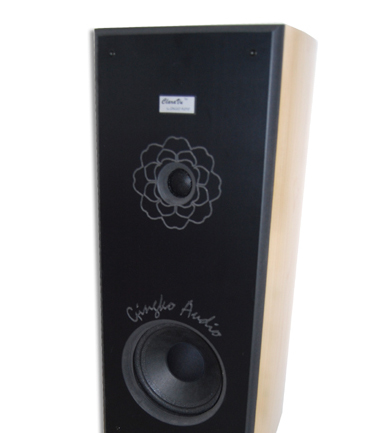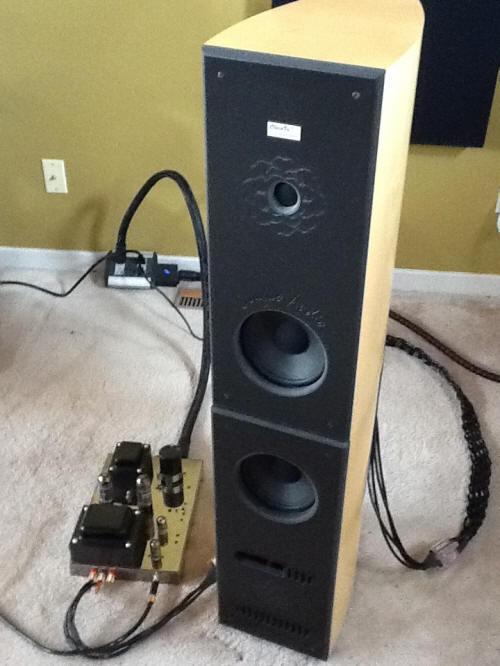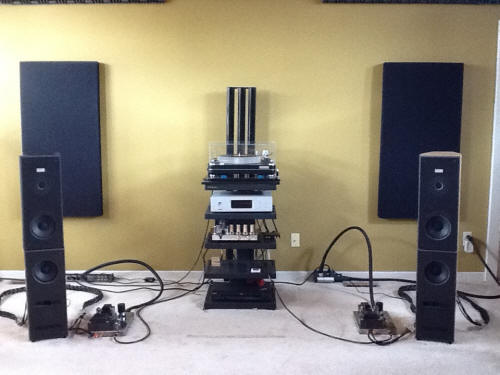|
|
You are reading the older HTML site
Positive Feedback ISSUE 67
gingko audio ClaraVu 7™ Modular Loudspeaker System and DanaCables as reviewed by John Zurek
If you own a turntable, like me, you are likely familiar with Gingko Audio. They are best known for their Cloud Vibration Control System, certainly one of the finest isolation devices that I know of. Back in ‘08 I got a chance to review the Cloud 9. I was so impressed I bought the review sample for my VPI Scoutmaster and use it to this day. Vinh Vu, the principal behind Gingko, ventured beyond the world of isolation and started building speakers a few years ago. His ClaraVu 88 received a great review by PFO's much-missed John Potis. Flash forward. Make way for the ClaraVu 7 modular speaker system, the latest from the Gingko line that includes of a pair of monitor speakers and matching powered subwoofers to provide full-range capability. Although the Gingkos may look like many other speakers, there's a lot of behind the scenes features that make them quite unique. First, each speaker is hand crafted (not built on an assembly line) in the USA. The monitor is a two-way speaker using a 1" soft dome tweeter and twin 6.5" paper cone woofers in a unique isobaric configuration. Two woofers are mounted in tandem—one in front of the other—in a sealed paperboard tube inside a rigid cabinet. This isobaric method allows the coupled driver pair to produce the same frequency response in half the box volume that a single driver of the same type would require. Interestingly, all the drivers are mounted to the cabinet, not the baffle. A combination of 85dB sensitivity and 8 ohm minimum impedance means the ClaraVu monitors are easily matched to a wide range of tube or solid state amplifiers. The same Isobaric design is used in the drivers of the subwoofer module, so although you only see two woofers, there are total of four working to send the lower bass your way. You don't need gobs of watts because the sub modules include a built-in amp that runs 75-watts into 8 ohms, or 100-watts into 4 ohms. Their impedance is listed at 10 ohms nominal, 8 ohms minimum, and 85dB sensitivity. There are adjustment options for gain, crossover frequency, and phase. According to Vinh, there several ways to hook up the subs:
I was lucky. Dana Robbins, the man behind DanaCable, the newest addition to the Gingko line of products, came over to my place to set up the ClaraVus which had just made their way down I-25 after duty at the 2012 RMAF in Denver. Dana left me with a few different lengths of his interconnects and an 8ft run of his unique looking 8-weave cable to use with the speakers. More about these gems later. The ClaraVus were fairly easy to set up, and we were able to get excellent spatial performance in 20 minutes or so. I used the same system for the entire review: Digital source was an Ayre CX-7eMP CD, analog included my VPI Scoutmaster/Blackbird with the Ray Samuels F117 phono, the preamp was a Dared MC 7 modded to a cathode-follower, and for power, the excellent Quicksilver 50-watt Mid-monos. My gut reaction after cranking up the Ayre CD, and feeding it some familiar discs, was that this was not a speaker (like so many I've heard lately) that is fatally obsessed with microscopic detail. The focus that I first heard from the Gingkos was on realistically engaging the listener with the music. After sampling a wide variety of discs over a week or so, I decided to insert the DanaCable speaker wires. All I can say is Wow. With the 8-weave DanaCable in the loop the Gingkos sprang to life. I was all of a sudden moving with the music. Involved. Glare removed, but sparkle added, and improved imaging cues. There was a palpable, natural flow and ease. Honestly, I've never been so moved by changing out one set of cables. My curiosity was totally piqued, so I pulled my interconnects out, and went with an all-DanaCable system. The last bit of glare vanished, and everything was more resolving, yet at the same time feeling smoother with an improved sense of pace. The DanaCables brought out the best in my system, elevating the ClaraVus to higher ground, as if they were meant to play together. A full review on the DanaCables will be coming soon. It took me a few days to settle on the balance of the sub modules. They have controls for gain, frequency, and phase. Dana set the frequency and phase in initial set-up, so I concentrated on gain. I loved this feature. Not as complicated as most dedicated subs are, it essentially let me adjust (at least some aspects) of the tonal character of the system by changing the gain of the low bass. Bass problems in your room? Most of us live with them in some form. The ClaraVu subs may provide an easy fix to bass woes, be they an over- or under-abundance.
After the cable change and sub dial-in, the sound I heard reflected the elegant tube glow of the Quicksilvers with a tight, generous bass that had impact. I fed the CD player "Gaslighting Abby", the opening track from Steely Dan's Two Against Nature. A fairly well recorded work, I wanted to hear the relationship between bass drum and bass guitar in the intro. Some speakers loose definition here and can blend the two instruments together. The ClaraVus were spot on; they easily delineated bass guitar and drum. Before I knew it I was in the middle of "West of Hollywood", the last track on the album. Vocals were clear with little to no coloration. Although Donald Fagen's voice is not one you usually seek out to highlight an audio system, he and Becker sure know how to compose, arrange, and mix background vocals. Those vocals were just stellar throughout this disc, and the mix of those airy voices (that I kept looking forward to) with lead vocals was clear and distinct, so very enjoyable. The Quicksliver 50-watt Mid-monos I used were an excellent match for the ClaraVus. These speakers love tubes, and 50-watts was more than enough to drive them to very high levels, whilst maintaining that delicious tubey character. The Ginkgos sounded excellent at low levels, but also kept their cool and handled wide dynamic swings with ease. A friend recently brought over a Peter Gabriel compilation called Hit/Miss. Frankly; I was shocked while listening to the monkey tune. The sheer abundance of forceful energy could confound many speakers. The ClaraVus really impressed with faithful slamming bass at high levels, right in your chest. This tune is not one of my faves, but it was so much fun I turned it up (I almost never do this) and listened again. I'm thinking this isobaric design really works. The Gingkos could rock, no doubt. But, in my world a good acoustic string sound is just as important. On Esperanza Spaulding's "Cuerpo Y Alma" (Body and Soul) from Esperanza, I noticed the physical scale of her double bass was right on. In fact the scale of the entire soundstage was very accurate with these speakers. Fundamentals and harmonics were easily distinguished. The attack had woody, warm timbre, plus that little buzz between notes so characteristic of this instrument was right there. The ClaraVus conjured up the essence of playing live acoustic jazz, the bassist a few feet away from my drums. For me no speaker is really complete unless they can do justice to serious or "legitimate" music as my conducting professor used to call it. I decided to go with the third movement from the Mount St. Helens Symphony, Volcano, by Alan Hovhaness. After being floored by what they did with the bass on the Peter Gabriel cuts, I must admit I was curious to hear how the Gingkos would handle all the low-frequency energy that you can surely imagine is contained in this piece. Ironically, the first thing that really caught my ear was the delicate celeste line that can be sometimes obscured. The subtle but complex overtones of this unique instrument were distinct, even at pianissimo. Soon after, the battery of percussion that symbolizes the volcano's fury went to work on my blood pressure, kicking it up more than a few points. I just had to punch the up arrow on the volume remote. The ClaraVus did not flinch. And yes, these speakers do kick some righteous bass. At the same time, the massed strings were able to coexist with the dense and complex layering of percussion and brass. More importantly, attack and delay of the strings was faithfully rendered, as was the natural reverb of the hall. The Gingkos let me experience the composer's interpretation of the volcano's eruption, doing justice to complexity, timing and texture, but most of all the intense emotion. If you consider the individual components of this speaker system, the ClaraVu monitors are damn fine speakers on their own. But, just as you might expect, they can't provide that big heft, that punchy bass I crave. Add the sub modules and that all changes, including a dramatic increase to the size of the soundstage. Although the Gingkos do not go down to 20Hz, adding the subs to the monitors is a night-and-day improvement. Their bass performance is simply remarkable, especially for the cabinet size. Fast, accurate and very satisfying, albeit without the lowest octave, I'm glad Gingko chose a wise cut-off frequency instead of trying to take them lower just for specification's sake. My rough reckoning had useful bass cutting off at about 36Hz in my room. If your space is limited, or low-bass impact is not a high priority, the monitors by themselves are an easy recommend. If funding is a problem, you might want to buy the monitors first, and then graduate up to the full modular system, an easy upgrade. As my listening progressed I noticed a pattern with the Ginkgos that was unusual – at least for me - when I'm in reviewing mode. I'd put on a CD or vinyl to check out a track for one particular trait to see how the speakers handled it, and I'd end up listening to the whole recording. I found my self wanting to enjoy, not review. Cliché? Maybe, but true it was. The ClaraVus did not steer me to listen to any particular type of recording or music genre. Sure, audiophile-approved discs sounded great. All my other discs… that detail-obsessed speakers would have rendered unlistenable? The Gingkos let me enjoy (most of) them again. Don't get me wrong. This is not a speaker system that just glosses over details to give you an easy-listening experience. It's one with tonal substance that lets you listen, then listen some more, and enjoy. They combined rich textures and life-like dynamics to create a musical, natural experience. Go with your gut reaction. In this case mine was right. Here's the take-away: If you're tired of the anemic, over-resolving sound that so many speakers seem to favor, and you‘d like to get back to the pleasure of thoroughly enjoying your music, the Gingko Audio ClaraVu 7 Modular Speaker system coupled with DanaCable speaker wires and interconnects is the way to go. John Zurek
Monitor
Speakers
Powered
Sub Modules
Gingko Audio
|










